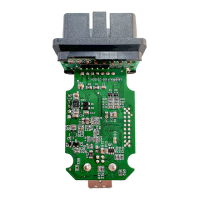RM0090 Rev 18 1399/1749
RM0090 USB on-the-go high-speed (OTG_HS)
1543
35.10 FIFO RAM allocation
35.10.1 Peripheral mode
Receive FIFO RAM
For Receive FIFO RAM, the application should allocate RAM for SETUP packets: 10
locations must be reserved in the receive FIFO to receive SETUP packets on control
endpoints. These locations are reserved for SETUP packets and are not used by the core to
write any other data.
One location must be allocated for Global OUT NAK. Status information are also written to
the FIFO along with each received packet. Therefore, a minimum space of (Largest Packet
Size / 4) + 1 must be allocated to receive packets. If a high-bandwidth endpoint or multiple
isochronous endpoints are enabled, at least two spaces of (Largest Packet Size / 4) + 1
must be allotted to receive back-to-back packets. Typically, two (Largest Packet Size / 4) + 1
spaces are recommended so that when the previous packet is being transferred to AHB, the
USB can receive the subsequent packet.
Along with each endpoints last packet, transfer complete status information are also pushed
to the FIFO. Typically, one location for each OUT endpoint is recommended.
Transmit FIFO RAM
For Transmit FIFO RAM, the minimum RAM space required for each IN Endpoint Transmit
FIFO is the maximum packet size for this IN endpoint.
Note: More space allocated in the transmit IN Endpoint FIFO results in a better performance on
the USB.
35.10.2 Host mode
Receive FIFO RAM
For Receive FIFO RAM allocation, Status information are written to the FIFO along with
each received packet. Therefore, a minimum space of (Largest Packet Size / 4) + 1 must be
allocated to receive packets. If a high-bandwidth channel or multiple isochronous channels
are enabled, at least two spaces of (Largest Packet Size / 4) + 1 must be allocated to
receive back-to-back packets. Typically, two (Largest Packet Size / 4) + 1 spaces are
recommended so that when the previous packet is being transferred to AHB, the USB can
receive the subsequent packet.
Along with each host channels last packet, transfer complete status information are also
pushed to the FIFO. As a consequence, one location must be allocated to store this data.
Transmit FIFO RAM
For Transmit FIFO RAM allocation, the minimum amount of RAM required for the host
nonperiodic Transmit FIFO is the largest maximum packet size for all supported nonperiodic
OUT channels. Typically, a space corresponding to two Largest Packet Size is
recommended, so that when the current packet is being transferred to the USB, the AHB
can transmit the subsequent packet.
The minimum amount of RAM required for Host periodic Transmit FIFO is the largest
maximum packet size for all supported periodic OUT channels. If there is at least one High

